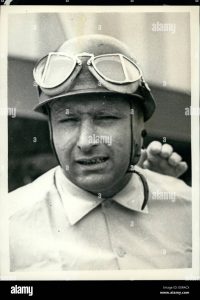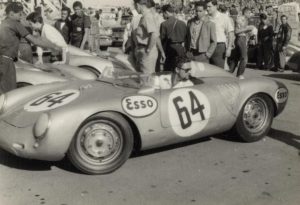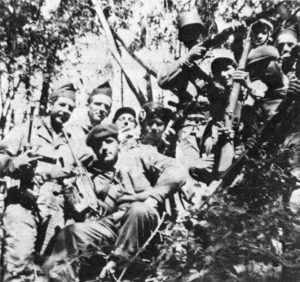
“Juan Manuel Fangio, five-time world champion, was more than a driver—he was grace under pressure.”1 With five championships to his name, a hero to the people in Argentina, and global recognition, Fangio was a legendary Formula One driver celebrated for his many achievements and awards. But in 1958, something happened off the track that tested his true character. The day before the Cuban Grand Prix, while mentally preparing for the race in his Havana hotel room, Fangio heard a knock on the door. Waiting for him were Cuban revolutionaries, ready to take him hostage and use him as a political symbol. Without a fight, Fangio calmly went with his kidnappers. Even when he was off the track, he stayed calm and kept his attention focused. This article will explore not only the 1958 Cuban Grand Prix, but also how Fangio’s response that day revealed the depth of his character.
Fangio wasn’t just known for being a legendary driver—he was a symbol of hard-work, talent, and known for staying calm under pressure. With five world championships to his name by the late 1950s, Fangio was a national hero in Argentina and a household name around the world. Fans traveled globally just to watch him race. As Donaldson notes, “Juan Manuel Fangio’s illustrious name is indelibly inscribed in the record books and many consider him to be the greatest driver in history.”2 His mere presence at any international race guaranteed that there would be press coverage and an attentive audience, making him the perfect figure for movements seeking global attention. This is exactly the reason why the Cuban government, under the leadership of Fulgencio Batista, wanted to host the Cuban Grand Prix. Batista was declining in popularity with the people of Cuba and wanted to use the race to gain attraction to Cuba—not only to boost the economy by increasing money spent at the casinos, but also to increase tourism in the area. The Cuban Grand Prix was going to be Batista’s way to escape and change people’s image of him during a politically turbulent era—using international events, as Britannica notes, “as a means of improving their image abroad and of stimulating economic and technological progress.”3 The streets of Havana turned into a huge visual site of political propaganda. Batista thought he had it all, but little did he know. Behind the scenes, however, Cuba was soon to change. Someone else was also out there trying to boost his image. As Fidel Castro’s revolutionary movement gained traction, the race served as a metaphor for the growing struggles of ordinary Cubans in the 1950s. Juan Manuel Fangio being kidnapped the night before the Grand Prix ruined Batista’s plans to show off this “lucious” Cuba as a nice, tourist-friendly place. Instead, it opened the doors to the revolutionary regime’s image and brought global attention to the unrest simmering beneath the surface—part of what Encyclopedia Britannica describes as “a widespread underground movement… intended to bring down Batista’s regime.”4

It was the night before the Cuban Grand Prix, on February 23, 1958. Fangio was relaxing in his hotel room at Hotel Lincoln in Havana, mentally preparing with his team for the race ahead of him. Despite the political tension surrounding the event, nothing seemed out of the ordinary. It was supposed to be just another race day for him. That was the moment when a sharp knock came at his hotel door. Standing at the door were two young Cuban revolutionaries. At first, Fangio thought it was a fan playing a prank because of how calm they were, but he quickly realized they were armed. One of them looked Fangio sternly in the eyes and stated, “You are under arrest, Señor Fangio.” Without putting up a fight or panicking, so as not to risk alarming his team inside the hotel, Fangio told them, “I understand. Let’s go.”5 His response showed how aware and quick on his feet he was. He remained cool and composed, reflecting the same mentality he showed on the racetrack. The rebels took him through the halls of the hotel and out into a vehicle that was waiting for the kidnappers. Fangio was basically the face of the event, and he became a symbolic hostage for Cuba’s unrest. His kidnapping wasn’t random—it was strategic, calculated, and carefully thought out to vocalize the revolutionary change through the body of Fangio. They were going to capture headlines around the globe. As Encyclopedia Britannica notes, “Castro’s rebels knew that taking Fangio would bring worldwide attention.”4 They wanted to shame Batista on a worldwide level and expose Cuba’s unrest. With Batista’s popularity on the decline and Fangio’s at an all-time high, it was like putting a failing engine up against a world champion at full throttle. It was sure to create an impact all around the world.

Fangio surprisingly had a good time in captivity, which shocked me and many authors—not just because of the severity of what happened, but because of how he handled it so calmly. After being taken from his hotel, the rebels brought him to a quiet apartment in Havana. It wasn’t a grimy pit or a crack house like we might imagine; it was a regular middle-income apartment—just guarded. He was treated like a guest coming to watch the game with friends instead of a prisoner. The kidnappers gave him food, made conversation, and even allowed him to watch the Cuban Grand Prix on TV with them. They explained that they meant no harm and saw him simply as the easiest way to make a statement. Though he had every reason to be angry or afraid, Fangio remained calm and respectful throughout, sensing no need to act out as long as the kidnappers remained respectful and honest. It showed on both sides. His actions during this time revealed the kind of man he truly was. There was no panic, no acting out of any sort. Fangio was calm and collected even with his life in their hands. He knew that any wrong move could worsen the situation, so instead, he chose kindness and understanding. He even made sure to treat the revolutionaries with the same calm spirit he showed his pit crew on race days. As Ludvigsen mentions, “You have kept your word. I’m grateful.”7 This quote became meaningful because it wasn’t that the quote was just polite—it was powerful. It showed how he saw the good side in everyone, even in those who put his life at risk and had taken him hostage. Fangio’s mentality was something else—he accomplished the almost impossible: finding and making peace in moments of political conflict. Everyone who attended the race, and people who listened around the world, followed the story closely. When they learned how he handled the situation, their admiration only grew. They figured if their hero had this respect and understanding for his kidnappers, they should too. His grace under pressure made headlines, becoming the new face of Cuba’s revolutionary change to come. Fangio’s composed attitude during his captivity only deepened the world’s admiration—turning him, in the eyes of many, into even more of a hero. 5. Pierre Menard and Jacques Vassal, Juan Manuel Fangio: The Race in the Blood (Paris: Chronosports, 2003), 16.] Fangio didn’t just survive the kidnapping– he actually became more of a hero because of it. The world saw not only a champion in racing, but a champion in character, and to some, even a hero in Cuba’s movement for change.
Later that year, Fangio retired—not just as a five-time world champion, but now as someone respected for his character as much as his driving. What happened in Havana didn’t tarnish his legacy or affect his character—it became just another adventure. Around the world, people didn’t just admire his driving skills; they admired his ability to be calm in crisis and be a part of something with influence far beyond racing. Fangio could have walked away from the incident with the worst attitude, but he didn’t. As Donaldson puts it, “What had occurred revealed that Fangio’s bravery… defined his character and legacy.”8 In the end, Fangio proved that greatness isn’t just measured in wins—it’s measured in how you carry yourself when everything is at risk.
- Gerald Donaldson, Fangio: The Life Behind the Legend (London: Virgin Books, 2009), 320. ↵
- Gerald Donaldson, Fangio: The Life Behind the Legend (London: Virgin Books, 2009), 7. ↵
- “Formula One,” Encyclopedia Britannica Online, accessed April 12, 2025. ↵
- “Fidel Castro,” Encyclopedia Britannica Online, accessed April 12, 2025. ↵
- Gerald Donaldson, Fangio: The Life Behind the Legend (London: Virgin Books, 2009), 243. ↵
- “Fidel Castro,” Encyclopedia Britannica Online, accessed April 12, 2025. ↵
- Karl Ludvigsen, Juan Manuel Fangio: Motor Racing’s Grand Master (Newbury Park, CA: Haynes Manuals Inc., 1999), 179. ↵
- Gerald Donaldson, Fangio: The Life Behind the Legend (London: Virgin Books, 2009), 237. ↵

